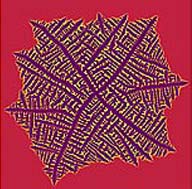Computer simulations mimic growth of ’dizzy dendrites’

Computer simulation of the crystal structure for a copper-nickel alloy with randomly dispersed particles.
Crystals are more than just pretty faces. Many of the useful properties associated with metal alloys or polymer blends — like strength, flexibility and clarity — stem from a material’s specific crystal microstructure. So the more scientists know about how crystal patterns grow as a material solidifies, the better they’ll be able to create new materials with specific properties.
In a recent issue of Nature Materials, National Institute of Standards and Technology (NIST) researchers described work with collaborators in Hungary and France using computer simulations of crystal growth to advance understanding of how foreign particles — either additives or impurities — affect crystal growth patterns. They found that computer simulations developed to predict the crystal growth of metal alloys matched up remarkably well with microscope images of actual crystals grown in polymer films with thicknesses far below that of a human hair.
Randomly dispersed foreign particles in both the simulation and the real materials produced what the researchers dubbed “dizzy dendrites.” In both cases, the tree-like branches in the crystals tend to curve and split, instead of forming the straight, symmetric patterns typical of pure crystals. Further simulations indicated that rotating the particles in concert during the solidification process produced spiraling dendrites.
Alternating strips of particles with first one and then another orientation produced zig-zagging patterns. The researchers suggest that experimentalists also may be able to reproduce the crystal patterns seen in these more complex simulations.
Possible methods include imprinting the crystal growing surface with a patterned roller (like those used to make a patterned pie crust) or using external electromagnetic fields or laser pulses to orient particles in specific directions.
Media Contact
More Information:
http://www.nist.gov/All latest news from the category: Materials Sciences
Materials management deals with the research, development, manufacturing and processing of raw and industrial materials. Key aspects here are biological and medical issues, which play an increasingly important role in this field.
innovations-report offers in-depth articles related to the development and application of materials and the structure and properties of new materials.
Newest articles

A universal framework for spatial biology
SpatialData is a freely accessible tool to unify and integrate data from different omics technologies accounting for spatial information, which can provide holistic insights into health and disease. Biological processes…

How complex biological processes arise
A $20 million grant from the U.S. National Science Foundation (NSF) will support the establishment and operation of the National Synthesis Center for Emergence in the Molecular and Cellular Sciences (NCEMS) at…

Airborne single-photon lidar system achieves high-resolution 3D imaging
Compact, low-power system opens doors for photon-efficient drone and satellite-based environmental monitoring and mapping. Researchers have developed a compact and lightweight single-photon airborne lidar system that can acquire high-resolution 3D…





















